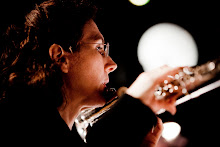
The notated C quarter-sharp in bar 241 is the 11th partial of G, and the A-flat in bar 245 is the 21st partial of E-flat (along with the indication that you are in a perfect fifth with the clarinet). I like having this kind of information in the score, but if he had notated the exact deviation in cents, that would have been even more helpful. This is easy enough to find out in Wiki
That 11th partial should a C# 49 cents flat, and the 21st partial should be an A-flat 29 cents flat. Like I said, easy enough for find out, but it would have been nice if the composer had provided this information.
We haven't had rehearsal yet, so I can't say how this will sound or how easy this will be to hear. [ed. read my follow up at the bottom of this post]
So now the question arises: How does one practice this stuff?
First of all, I get my tuner. Trying the A-flat first, I make sure that our Eb's are in tune. Then I play an A-flat ca. 29 cents flat. Then I keep that tone while putting the sound on to Eb and I hear a Bb combination tone. This is a clue that I am on the right track, or within the correct overtone spectrum. Your combination tone (it may be a true difference tone or not, depending on the timbre and register of instrument) should lie in close relationship to the fundamental - say an octave, fifth or major third (which is the 5th partial, you don't want to go much farther than that). Put in simpler terms, it should be part of the major triad formed by the fundamental.
Now to try the C# against the G. Again I tune the G's, then test my C3 so the needle goes about 49 cents flat, then put the sound on G. My difference tone is B natural this time, still close enough (a major third - the 5th partial) in relation to G to be correct.
Again, I have no idea how this will work in the context of the piece, or if it will be heard. But now I know, theoretically, how much adjustment is "correct".
Whether this works in context or not, I love working with combination tones. Scientists are still not in agreement as to what they are - but it is a wonderful example of how our brains work - how they "fill in the blanks" of the overtone spectrum. I wonder if this is the same phenomenon that allows transistor radios to work? Only the upper partials are projected, the brain fills in the rest.
Also, I've noticed that I'm one of those people who can read things like this, hence my spelling problems, most likely. (Thanks to my like-minded Uncle T for this text):
fi yuo cna raed tihs, yuo hvae a sgtrane mnid too
Cna yuo raed tihs? Olny 55 plepoe out of 100 can.
i cdnuolt blveiee taht I cluod aulaclty uesdnatnrd waht I was rdanieg. The phaonmneal pweor of the hmuan mnid, aoccdrnig to a rscheearch at Cmabrigde Uinervti sy, it dseno't mtaetr in waht oerdr the ltteres in a wrod are, the olny iproamtnt tihng is taht the frsit and lsat ltteer be in the rghit pclae. The rset can be a taotl mses and you can sitll raed it whotuit a pboerlm. Tihs is bcuseae the huamn mnid deos not raed ervey lteter by istlef, but the wrod as a wlohe. Azanmig huh? yaeh and I awlyas tghuhot slpeling was ipmorantt!
[Follow-up added May 5, 2009]
The passage in question was acually not so difficult to hear! You are a part of this "lump" of sounds that are related to the fundamental. It is tricky that he has two harmonic spectrums going at once: those of G and E-flat.
When considering dynamics in this piece we realized that there was a lot more going on than just playing loudly or softly. It helped to think of crescendo/decrescendo passages as adding/subtracting harmonics to your individual sound rather than just making the sound louder or softer. This made for a much more interesting color. Also, the very quiet passages must be played with focus and good attack. Even the quietest notes need some harmonics in the sound, none of this fluffy airy stuff! It just didn't match the color system.
I do admit the 11th partial gave me the most trouble in this piece. Tricky to hear! It must be 49 cents flat. I must make some exercises.
Speaking of which, I asked the composer and my colleagues how one can study and practice this music. The answer is always the same, learn the overtone series, horizontally, note by note, by ear. How can one do this? Programming a synthesizer seems to be the most popular idea. However you do it, once the sounds are in your head, you have to find a way to play them (of course, in a comfortable range of your instrument. I'm thinking middle octave) by using a combination of alternate fingerings and lip bending. Another project for me!


No comments:
Post a Comment